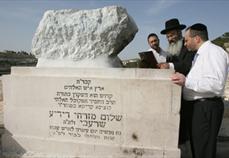 Jerusalem – The world’s oldest Jewish cemetery just went online.
Jerusalem – The world’s oldest Jewish cemetery just went online.
Subscribe to our Daily Roundup Email
A new project undertaken by the City of David archeological Park, located south of Jerusalem’s Old City and at the foot of the Mount of Olives cemetery, has begun the process of identifying and documenting tombstones throughout the entirety of the Mount of Olives and uploading the data to the Web.
Tens of thousands of graves on the mount have already been mapped and incorporated into a database, in the first-ever attempt to restore the graves and record the history of those who were buried there. The project includes the creation of a Web site (www.mountofolives.co.il) that aims to raise awareness of the City of David and to honor the memory of those buried in the cemetery, as well as to inform about the tours and activities available.
Additionally, the Web site tells stories of the people buried in the cemetery and, through a simple search window, one can locate the documented graves by name.
“We hope that this Web site will give people all over the world the opportunity to remove the dust of generations from the graves of their loved ones, and to both restore and reveal the stories buried underground,” Udi Ragones, the public relations director for the project, told The Jerusalem Post on Thursday.
“There’s so much history there, so many stories, that this project is fascinating both from a personal perspective as well as an historical one,” he said.
While more than 20,000 gravestones have already been documented, organizers estimate that there are between 200,000 and 300,000 in the cemetery, which leaves an enormous amount of work left to be done.
The already documented graves include those of the reviver of the Hebrew language, Eliezer Ben-Yehuda, Nobel Prize for Literature laureate Shai Agnon, former prime minister Menachem Begin, Hadassah Women’s Organization founder Henrietta Szold, founder of the Bezalel Art School Boris Schatz, Chaim ben Moses ibn Attar, also known as the Ohr ha-Chaim after his popular commentary on the Torah, and Rabbi Avraham Yitzhak Kook, the first Ashkenazi chief rabbi of the British Mandate.
Burial on the Mount of Olives dates back around 3,000 years, to the First and Second Temple periods, and continues to this day. Under Jordanian rule, from 1948-1967, the cemetery was badly vandalized. Tombstones were destroyed, broken and uprooted and many were used to pave the floors of Jordanian army encampments.
During this time, a road was paved from the top of the mountain southward, and the road to Jericho was widened, all on top of graves.
After the Six Day War, the cemetery was slowly restored. Yet until now, there has been no major effort to map and record the graves and to decipher and restore the names on all the tombstones.
The number of grave-sites listed on the Web site continues to grow, as workers identify them and pinpoint their location on the map. The site allows users to visit the cemetery through the use of a zoomable aerial photo of the Mount of Olives and a photo of each grave.
Every name listed includes the available information about that person and a photograph, with the option for the user to upload more data and photos about their loved ones and acquaintances who are buried on the mount.
The Web site also lets visitors create a tourist map and route of the graves that they wish to visit that can be printed complete with driving and parking instructions.

This is truly an amazing thing, but how sad is it that out of all the giants buried there they had to mention the few zionist apikorsim like ben yehuda and shay agmon, heartbreaking that they don’t appreciate our beautiful heritage.
Joey read – Chaim ben Moses ibn Attar, also known as the Ohr ha-Chaim after his popular commentary on the Torah, and Rabbi Avraham Yitzhak Kook, the first Ashkenazi chief rabbi of the British Mandate.
and also I thought that Nobel Prize for Literature laureate Shai Agnon was orthodox ???
Eliezer Ben-Yehuda accomplished much even though he was not orthodox as did , former prime minister Menachem Begin,
in making the press release they have to appeal to a wider audiance – not just the frum velt
The Zionists can’t be trusted to preserve a cemetary as they have uprooted many of them for roads in the past. In grouping the ohr hachaim with Lehavdil Ben-Yehuda, we can see where this project is headed.
Gedolim as the Ohr Hachaim don’t need these people to protect their gravesites they can do it themselves.
There is a story of the Arabs that tried to build a road through the Kever of the Ohr Hachaim, and on three tries the tractor flipped over, and they abandoned their quest.
maybe we should have an internet website for the purpose of organizing minyonim at gravesites in cemeteries. it happens frequently that 2 or more groups go to the same cemetery on the same day and look for minyan and cant find minyan. i was once at a cemetary looking for a minyan and couldnt find a minyan. there were at least 5 men visiting a nearby grave for a yohrtzeit and later in the day there were at least 5 men visiting another grave for another yohrtzeit and nobody had minyan because the different groups going to the cemetary that day did not coordinate with each other to meet each other to make minyonim and help each other out to have minyon at every gravesite.
the main obtacle to this is that most frum people follow the advice of rabonim to not use the internet and this makes it difficult to find people who are looking for a minyan.